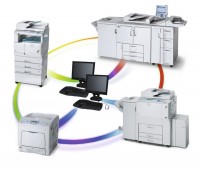 The company’s new report found that most models in the market have a “lack of compliance”, with most of these “significant limitations”.
The company’s new report found that most models in the market have a “lack of compliance”, with most of these “significant limitations”.
The report studies the “ability of the printer to provide sufficient data so that an advanced MPS technology can potentially drive the services”, with readers advised “a high MPS compliant ratio is not enough to ensure a profitable business free from unneeded toner deliveries and toner waste”, with the company encouraging users to “use Nubeprint MPS technology to obtain the best results” with automatic fulfilment.
Devices are not differentiated in the analysis by size, just by type – laser, inkjet, ribbon or wide-format – with 41 manufacturers’ devices included in the latest report. Ribbon and wide-format machines, Nubeprint added, are “small” in number compared to office machines, but their management “is a real burden to the customer”, and the demand “is high” for providers to provide consumables for the two types of machine.
2,400 models were selected, growing the selection from the previous report by 300 models, with HP dominating as the rest of the OEMs make up the remainder – interestingly, it appears Ricoh machines are comparable in terms of population to Canon and Xerox, while Brother and Lexmark are somewhat lesser in the rankings. Mono MFPs hold 31 percent share, while colour MFPs hold 30 percent, followed by monochrome with 19 percent and colour with 15 percent – wide-format and ribbon hold four and one percent share respectively.
In terms of compliance overall, the report found that “the distribution of models based on their compliance […] does not change significantly” to previous reports, but the “vast majority” of models in the market “have a lack of compliance to some degree”, with less than four out of 10, or around 39 percent, being compliant. Four percent require exclusion as it is “not possible to proactively manage the needs of these devices” remotely – with ribbon and wide-format devices “the biggest contributors” to non-compliance.
57 percent of devices tested “experience significant limitations that cause terrible headaches” to MPS providers, including false cartridge alerts or lack of alerts, and Nubeprint noted that “all except the non-compliant devices require an advanced MPS management technology”. In turn, “the problem becomes worse when using cartridges from different manufacturers”, and Nubeprint added that its Enterprise tool “is the only yield management tool that automatically solves these problems”.
In terms of device types, single-function devices “have the highest degree” of compliance, with 40 percent, compared to 30 percent of MFPs and copiers, and 10 percent of ribbon and wide-format printers – these two see 25 percent and 18 percent non-compliance overall. Colour is said to be “synonymous” with compliance, with only 10 percent having “major issues”, while monochrome devices with “major issues” make up around 35 to 50 percent of the total.
On an OEM comparison basis, compliance presents a “very heterogeneous market”, with some increasing compliance as others have gone backwards, with “no significant difference if the manufacturer […] is from the copier industry or printer industry”. A compliance index of OEMs meanwhile showed that very few OEMs can be said to be near 90 percent compliance, with most of the major printer OEMs around 40 to 80 percent compliant.
